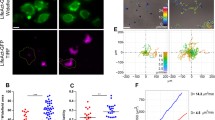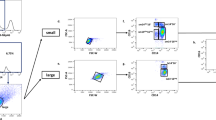Abstract
An important, early phenomenon during the development of immune cell interactions in vitro is the formation of multicellular aggregates. We have developed a quantitative assay to determine the kinetics of multicellular aggregate formation within a heterotypic population of cells on a flat surface. This assay follows the time rate of change in the value of an aggregation index for cells in undisturbed culture. For an initial, well-separated population of cells, the index is a minimum and remains at this value if the cells do not move and interact. By contrast, for conditions that promote active cell movement followed by interaction, the index value increases with time. The index, which reflects cells’ relative spatial distributions, is an “indirect enumeration” of the number of cells within aggregates as a function of time.
We used this index to follow the aggregative behavior of a population of freshly isolated human peripheral lymphocytes and monocytes. Previous studies have shown that monocytes are centrally located within aggregates and that lymphocytes move to surround monocytes. In order to test if lymphocyte movements are random or directed prior to interactions with monocytes, we formulated a simple model to describe changes in the expected number of cells in an “idealized aggregate” as a function of time. A comparison of the model curves with curves generated from the changes in the aggregation index shows that the best fit derives from a model that involves directed movement of lymphocytes toward monocytes. These results suggest that monocytes produce a chemoattracting agent for lymphocytes for these experimental conditions.
Similar content being viewed by others
References
Unanue, E. R. and Allen, P. M. (1987) The basis for the immunoregulatory role of macrophages and other accessory cells.Science 236, 551–557.
Paul, W. E. (1984)Fundamental Immunology, Raven, New York.
Springer, T. A. (1990) Adhesion receptors of the immune system.Nature 346, 425–434.
Hall, D. J., O’Leary, J. J., and Rosenberg, A. (1984) Effects of temperature on aggregation and the mitogen-induced exit of lymphocytes from the resting state.J. Cell Physiol. 121, 206–214.
Breanstrup, O., Andersen, V., and Werdelin, O. (1976) Macrophage-lymphocyte clusters in the immune response to soluble protein antigen. VIII. Cinephotomicrographic studies.Cell Immunol. 25, 207–216.
Petri, J., Br≸nstrup, O., and Werdelin, O. (1979)Scand. J. Immunol. 10, 493–498.
Jackola, D. R. and O’Leary, J. J. (1989) Monocyte requirement for mitogeninduced aggregation of human peripheral blood mononuclear leukocytes in vitro.Exp. Cell Res. 184, 119–130.
Fisher, E. S. and Lauffenberger, D. A. (1987) Mathematical analysis of celltarget encounter rates in two dimensions: the effect of chemotaxis.Biophys. J. 51, 705–716.
Feller, W. (1968)An Introduction to Probability Theory and Its Applications, vol. 1, John Wiley and Sons, New York, pp. 68–72, 228.
Weiss, G. H. (1967) First passage time problems in chemical physics, inAdvances in Chemical Physics, vol. 13 (Prigogine, I., ed.), Interscience Publishers, London, pp. 10–18.
Raman, R. K. (1977) Cellular aggregation towards steady point sources of attractant.J. Theoret. Biol. 64, 43–69.
Bell, G. I. (1978) Models for the specific adhesion of cells to celsl.Science 200, 618–627.
Szabo, A., Schulten, K., and Schulten, Z. (1980) First passage time approach to diffusion controlled reactions.J. Chem. Phys.,72, 4350–4357.
Neter, J. and Wasserman, W. (1974)Applied Linear Statistical Models, Richard D. Irwin, Inc., Homewood, IL, pp. 113–121.
Raman, R. K. (1976) Analysis of the chemotactic response during aggregation in dictyoselium minutum.J. Cell Sci. 20, 497–512.
Parrott, D. M. V. and Wilkinson, P. C. (1981) Lymphocyte locomotion and migration.Prog. Allergy 28, 193–284.
Wilkinson, P. C. (1986) The cocomotor capacity of human lymphocytes and its enhancement by cell growth.Immunology 57, 281–289.
Wilkinson, P. C. (1987) Lymphocyte locomotion in vitro: the role of growth activators and chemoattractants.Biomed. Pharmacotherapy 41, 329–336.
Grimes, G. J., and Barnes, F. S. (1973) A technique for studying chemotaxis of leukocytes in well-defined chemotactic fields.Exp. Cell Res. 79, 375–384.
Author information
Authors and Affiliations
Rights and permissions
About this article
Cite this article
Jackola, D.R., O’Leary, J.J. Evidence for lymphocyte chemotaxis toward monocytes during PHA-induced aggregation in vitro. Cell Biochem Biophys 20, 33–56 (1992). https://doi.org/10.1007/BF02782653
Received:
Accepted:
Issue Date:
DOI: https://doi.org/10.1007/BF02782653




